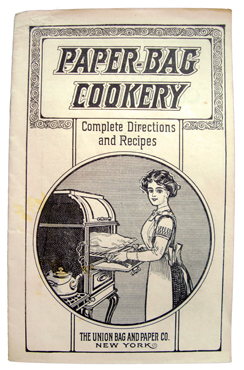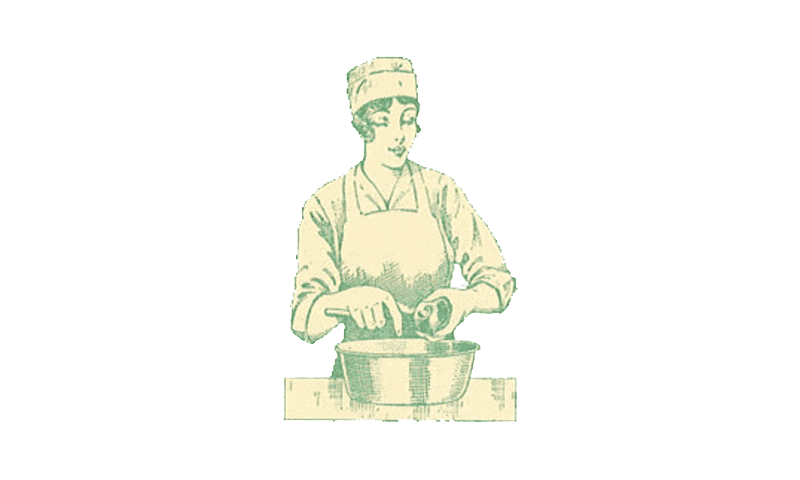1912: Paper Bag Cookery, Complete Directions and Recipes.
Union Bag and Paper Co., New York
What Paper-Bag Cookery Is
Cooking in paper bags is no longer a fad…. The theory is simple. Namely: That by sealing up food and then cooking it, the flavors, juices and food values are retained.
The Bags.
Do not use ordinary bags. They will make the food taste of paper. The special paper bags required are the Union Cookery Bags….Do not put wooden dishes or receptacles of any kind into the bags with meat, fish, poultry or vegetables. They are not only useless, but detrimental.
The Oven.
Any oven will do–coal, gas, oil, or electric. Nearly all ovens have wire or perforated shelves. If yours has a solid shelf, use a wire broiler or grid set over a pan. Never place the bag on a solid shelf. It is essential that heat circulate on all sides of the bag.
The shelves in modern ovens are movable and should be taken out when possible before heating the oven. The filled bag can then be place on the shelf and the shelf placed in the oven, being taken out in the same manner when the food is cooked. This avoids handling the bag and possibility of accident.
Don’t have the oven too hot. Union Cookery Bags require a moderate oven only. The old paper test of oven heat is good.
The bag will burst if placed upon a very hot surface at the start. Therefore, draw the wire or perforated shelf from the oven, or use a broiler or grid. This the filled bag is placed upon a cool surface and the whole heats up evenly at the same time when placed in the oven. Never place the bag upon a solid shelf.
Directions
1. Remove shelf from oven, if you don’t use a grid.
2. Prepare the food as usual.
3. Select a Union Cookery Bag amply large for the food to be cooked. Handle it carefully.
4. Moisten the bag slightly all over with water to make it pliable and avoid breaking.
5. Grease the bag inside with butter, drippings, lard or olive oil, using a brush or cloth.
6. Lay the bag flat on the table, lift the upper edge of the mouth and carefully insert the food.
7. Press the surplus air out of the bag.
8. Fold the mouth of the bag two or three times. Fold in the corners to insure hermetical closing. Fasten with three or four clips or pins.
9. Place the filled sealed bag on the wire or perforated shelf or grid, seam side up, and put in the oven. Do not place the bag too near the flames. The bag usually turns brown as cooking progresses. If it becomes very brown shortly after being placed in the oven or the slightest smell of scorching paper appears, reduce the heat, for the oven is too hot. Heat makes the bags brittle and they may break if touched during cooking.
If broiler or grid be used, set it over a shallow pan in the oven.
10. When the food is done draw the shelf or grid from the oven, or slip a plate gently under the bag and so remove it. To save the juices, cut a hole in the bottom of the bag and hold a dish under the opening.
11. Slit the bag with a sharp knife,remove it carefully from about the food and throw it away.
How to Know When food is Cooked.
Follow the Time Table. If the heat declines, or for any reason it becomes necessary to learn the progress of the cooking a long needle may be used to test the food. The small hole made will not injure the process.
If the bag should break while in use, enclose the food and broken bag in another bag, greased inside, and process as before.
To insure perfect browning, make a few holes in the top of the bag 5 or 10 minutes before the cooking is completed.
A Great Chef’s Opinion
..cooking of our food in a paper bag is not new. The present idea, without doubt, grew out of the old and familiar method of cooking en papillote. But the difference between these dishes en papillote and the old dishes were prepared and sometimes half cooked, before they were put into the paper…. In olden times our forefathers used to cook their game and fruits wrapped in leaves and parchment, and ourselves, when camping, frequently wrap a bird in a piece of old linen, then in coarse brown paper, and roast it on the ashes of the camp fire….
Many housekeepers have discovered how to freshen and re-heat bread by wrapping it in a paper bag.Biscuits that have been kept for twenty-four hours, while having lost only one per cent. or one-half per cent. of moisture by evaporation, are, nevertheless, dry. Their crusts are brittle, though the heart will be moist. If the moisture can be redistributed the biscuit will become almost as good as when first baked.Nothing will accomplish this redistribution as well as paper wrapping.
Soups cannot be cooked in bags, as the expansion caused by evaporation bursts the paper. Vegetables and desserts give varying success, some turning out to perfection and others proving less palatable. But eggs in every style, fish, entrees and roasts are always delicious, and it is here that the epicurean, though frugal housekeeper, will reap the many profits of paper-bag cookery….E. Bailly, Chef, Hotel St Regis, New York City
30-pages. Publisher: Union Bag and Paper Co., New York.



